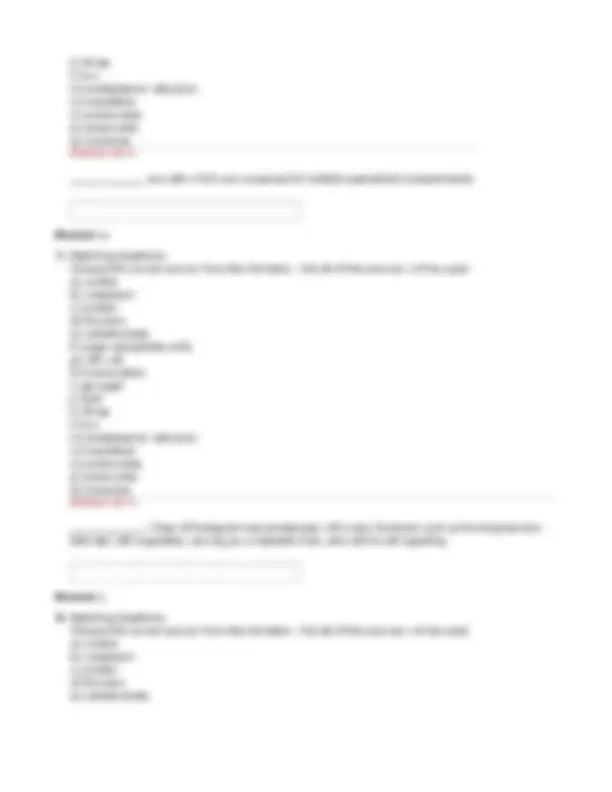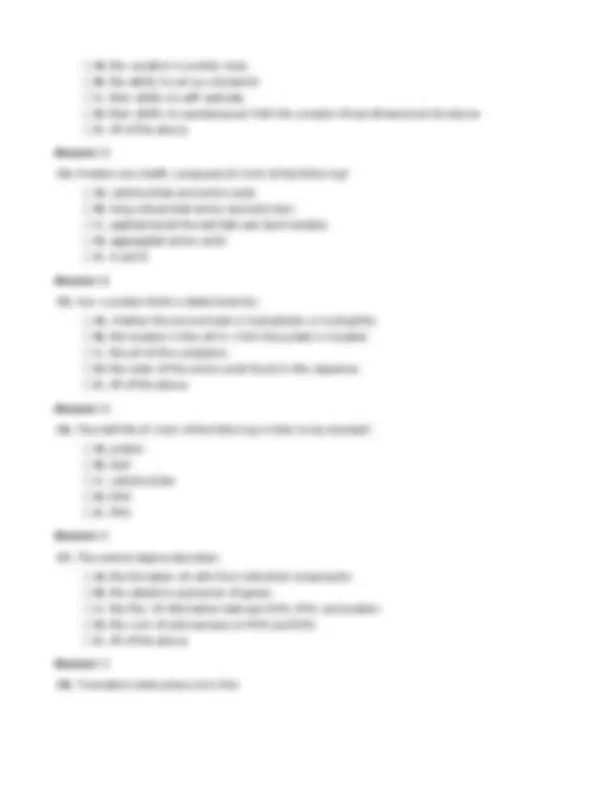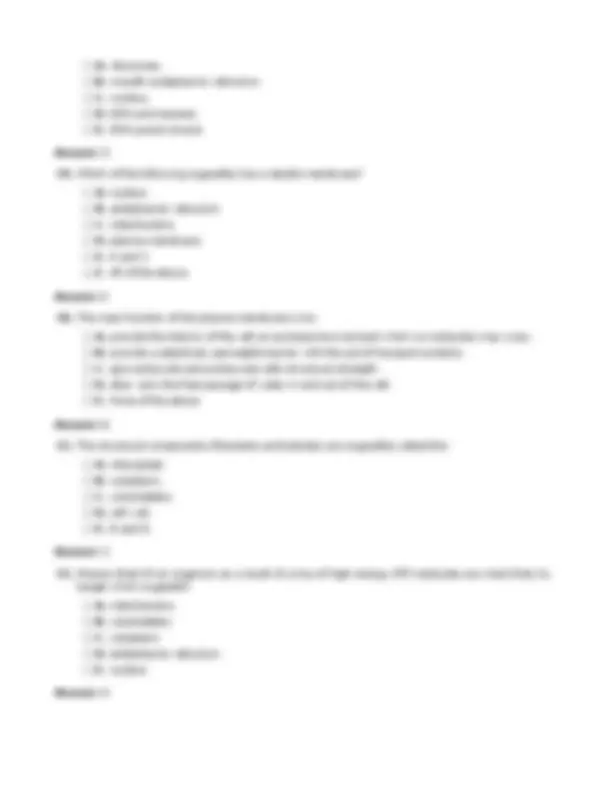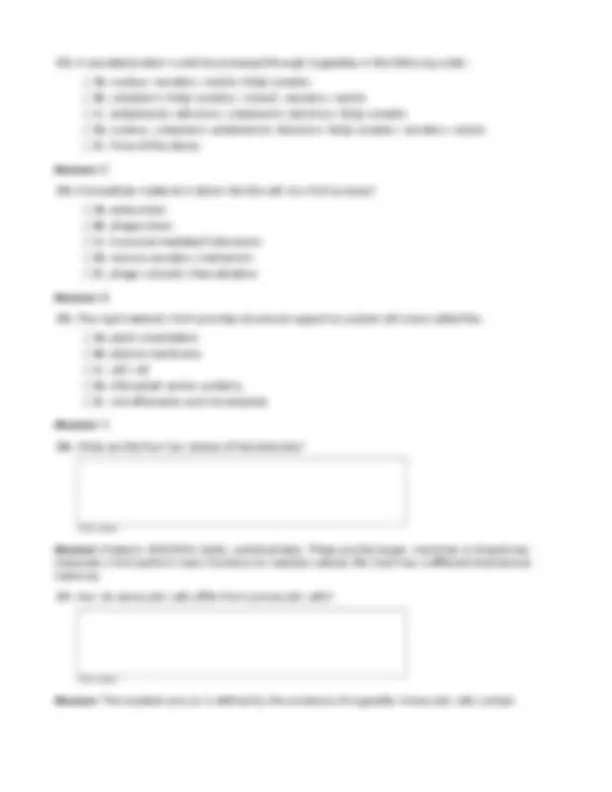








Study with the several resources on Docsity

Earn points by helping other students or get them with a premium plan


Prepare for your exams
Study with the several resources on Docsity

Earn points to download
Earn points by helping other students or get them with a premium plan
Community
Ask the community for help and clear up your study doubts
Discover the best universities in your country according to Docsity users
Free resources
Download our free guides on studying techniques, anxiety management strategies, and thesis advice from Docsity tutors
Material Type: Quiz; Class: Principles of Biochemistry; Subject: Biochemistry; University: Arizona State University - Tempe; Term: Summer I 2013;
Typology: Quizzes
1 / 12

This page cannot be seen from the preview
Don't miss anything!







1. Matching Questions Choose the correct answer from the list below. Not all of the answers will be used. a) uridine b) cytoplasm c) protein d) thymine e) carbohydrate f) sugar–phosphate units g) cell wall h) transcription i) glycogen j) lipid k) three l) two m) endoplasmic reticulum n) translation o) prokaryotes p) eukaryotes q) lysozome Reference: Ref 1- DNA is made from the building blocks adenine, guanine, cytosine, and ____________. Answer: d 2. Matching Questions Choose the correct answer from the list below. Not all of the answers will be used. a) uridine b) cytoplasm c) protein d) thymine e) carbohydrate f) sugar–phosphate units g) cell wall h) transcription i) glycogen j) lipid k) three l) two m) endoplasmic reticulum n) translation o) prokaryotes p) eukaryotes q) lysozome Reference: Ref 1-
____________: Unbranched polymer that, when folded into its three-dimensional shape, performs much of the work of the cell. Answer: c
3. Matching Questions Choose the correct answer from the list below. Not all of the answers will be used. a) uridine b) cytoplasm c) protein d) thymine e) carbohydrate f) sugar–phosphate units g) cell wall h) transcription i) glycogen j) lipid k) three l) two m) endoplasmic reticulum n) translation o) prokaryotes p) eukaryotes q) lysozome Reference: Ref 1- ____________: The number of hydrogen bonds formed between A and T. Answer: l 4. Matching Questions Choose the correct answer from the list below. Not all of the answers will be used. a) uridine b) cytoplasm c) protein d) thymine e) carbohydrate f) sugar–phosphate units g) cell wall h) transcription i) glycogen j) lipid k) three l) two m) endoplasmic reticulum n) translation
k) three l) two m) endoplasmic reticulum n) translation o) prokaryotes p) eukaryotes q) lysozome Reference: Ref 1- ____________ are cells which are composed of multiple specialized compartments. Answer: p
7. Matching Questions Choose the correct answer from the list below. Not all of the answers will be used. a) uridine b) cytoplasm c) protein d) thymine e) carbohydrate f) sugar–phosphate units g) cell wall h) transcription i) glycogen j) lipid k) three l) two m) endoplasmic reticulum n) translation o) prokaryotes p) eukaryotes q) lysozome Reference: Ref 1- ____________: Class of biological macromolecules with many functions such as forming barriers between cell organelles, serving as a metabolic fuel, and cell-to-cell signaling. Answer: j 8. Matching Questions Choose the correct answer from the list below. Not all of the answers will be used. a) uridine b) cytoplasm c) protein d) thymine e) carbohydrate
f) sugar–phosphate units g) cell wall h) transcription i) glycogen j) lipid k) three l) two m) endoplasmic reticulum n) translation o) prokaryotes p) eukaryotes q) lysozome Reference: Ref 1- ____________: Highly organized region of the cell where glycolytic metabolism occurs. Answer: b
9. Matching Questions Choose the correct answer from the list below. Not all of the answers will be used. a) uridine b) cytoplasm c) protein d) thymine e) carbohydrate f) sugar–phosphate units g) cell wall h) transcription i) glycogen j) lipid k) three l) two m) endoplasmic reticulum n) translation o) prokaryotes p) eukaryotes q) lysozome Reference: Ref 1- ____________: Responsible for protein processing and xenobiotic metabolism. Answer: m 10. Matching Questions Choose the correct answer from the list below. Not all of the answers will be used. a) uridine
16. Heritable information is packaged into discrete units called _______. Answer: genes 17. A group of enzymes called _______ catalyze replication. Answer: DNA polymerase 18. Although all cells in an organism have the same DNA, tissues differ due to selective _______. Answer: expression 19. The basic unit of life is considered the _______. Answer: cell 20. Large particles of extracellular material are taken into the cell via: Answer: phagocytosis 21. The structure of DNA described by Watson and Crick included: A. a double helix. B. the sugar–phosphate backbone aligned in the center of the helix. C. the base pairs that are stacked on the inside of the double helix. D. A and B. E. A and C. Answer: E 22. In higher organisms, which of the following is composed of a polymer with double-stranded phosphodiester-linked monomers? A. RNA B. DNA C. protein D. carbohydrate E. None of the above. Answer: B 23. What gives proteins such a dominant role in biochemistry?
A. the variation in protein sizes B. the ability to act as a blueprint C. their ability to self-replicate D. their ability to spontaneously fold into complex three-dimensional structures E. All of the above. Answer: D
24. Proteins are chiefly composed of which of the following? A. carbohydrate and amino acids B. long unbranched amino acid polymers C. peptide bonds formed between lipid moieties D. aggregated amino acids E. A and B Answer: B 25. How a protein folds is determined by: A. whether the environment is hydrophobic or hydrophilic. B. the location in the cell in which the protein is located. C. the pH of the cytoplasm. D. the order of the amino acids found in the sequence. E. All of the above. Answer: D 26. The half-life of which of the following is likely to be shortest? A. protein B. lipid C. carbohydrate D. DNA E. RNA Answer: E 27. The central dogma describes: A. the formation of cells from individual components. B. the selective expression of genes. C. the flow of information between DNA, RNA, and protein. D. the work of polymerases on RNA and DNA. E. All of the above. Answer: C 28. Translation takes place on/in the:
33. A secreted protein would be processed through organelles in the following order: A. nucleus; secretory vesicle; Golgi complex B. cytoplasm; Golgi complex; cytosol; secretory vesicle C. endoplasmic reticulum; cytoplasmic reticulum; Golgi complex D. nucleus; cytoplasm; endoplasmic reticulum; Golgi complex; secretory vesicle E. None of the above. Answer: E 34. Extracellular material is taken into the cell via which process? A. endocytosis B. phagocytosis C. lysosome-mediated indocytosis D. reverse secretory mechanism E. phago-cytosolic internalization Answer: B 35. The rigid material which provides structural support to a plant cell is/are called the: A. plant cytoskeleton B. plasma membrane C. cell wall D. chloroplast anchor proteins E. microfilaments and microtubules Answer: C 36. What are the four key classes of biomolecules? HTML Editor Answer: Proteins, DNA/RNA, lipids, carbohydrates. These are the larger, monomer or biopolymer molecules which perform many functions to maintain cellular life. Each has a different biochemical make-up. 37. How do eukaryotic cells differ from prokaryotic cells? HTML Editor Answer: The simplest answer is defined by the existence of organelle. Eukaryotic cells contain
organelles including a nucleus, while prokaryotic cells do not have such compartments.
38. Describe the central dogma and why it is important for cell life. HTML Editor Answer: This is the phrase coined by Francis Crick and is the overview of how a cell uses the information from DNA to produce RNA, protein, and more DNA. Much of the fate of a cell (metabolism, survival, growth, movement, and cell differentiation) is based on the control of the central dogma. Which genes are transcribed and translated defines the function of a cell. 39. Define an organelle. HTML Editor Answer: An organelle is often, but not always, enclosed by a membrane. Examples include the nucleus, mitochondria, and chloroplasts. However, the cytoplasm is defined as that area surrounded by the plasma membrane, excluding the organelles. 40. What is the role of the endoplasmic reticulum (ER)? HTML Editor Answer: The endoplasmic reticulum is series of membrane tubes or sacs. When studded with proteins (ribosomes), the endoplasmic reticulum is considered rough ER and is involved with the processing of nascent protein. Smooth ER is involved in maturing proteins and carbohydrates, and is responsible for xenophobic metabolism of foreign compounds. 41. Of the biochemical macromolecules, which class is chiefly responsible for catalysis of cellular processes? Answer: Proteins. 42. DNA and RNA are composed of what basic biochemical compounds?